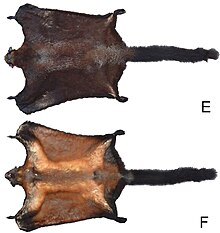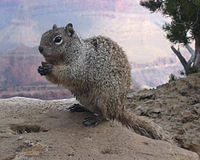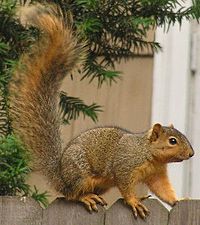
Squirrels are members of the family Sciuridae, a family that includes small or medium-size rodents. The squirrel family includes tree squirrels, ground squirrels, and flying squirrels. Squirrels are indigenous to the Americas, Eurasia, and Africa, and were introduced by humans to Australia. The earliest known fossilized squirrels date from the Eocene epoch, and among other living rodent families, the squirrels are most closely related to the mountain beaver and to the dormice.

Bushmeat is meat from wildlife species that are hunted for human consumption, most often referring to the meat of game in Africa. Bushmeat represents a primary source of animal protein and a cash-earning commodity for inhabitants of humid tropical forest regions in Africa, Latin America and Asia. Bushmeat is an important food resource for poor people, particularly in rural areas.

Flying squirrels are a tribe of 50 species of squirrels in the family Sciuridae. Despite their name, they are not in fact capable of full flight in the same way as birds or bats, but they are able to glide from one tree to another with the aid of a patagium, a furred parachute-like skin membrane that stretches from wrist to ankle. Their long tails also provide stability as they glide. Anatomically they are very similar to other squirrels with a number of adaptations to suit their lifestyle; their limb bones are longer and their hand bones, foot bones, and distal vertebrae are shorter. Flying squirrels are able to steer and exert control over their glide path with their limbs and tail.

Sciurinae is a subfamily of squirrels, uniting the flying squirrels with certain related tree squirrels. Older sources place the flying squirrels in a separate subfamily (Pteromyinae) and unite all remaining sciurids into the subfamily Sciurinae, but this has been strongly refuted by genetic studies.

Biswamoyopterus is a genus of rodent in the family Sciuridae. It contains three known species of very large flying squirrels, with B. laoensis being among the longest of all squirrels. They are distributed in forests in northeast India, southwest China and Laos. Despite their size, species in this genus tend to be very elusive; due to this, all of them have been described relatively recently. Additionally, they are easily confused with certain Petaurista giant flying squirrels that are more common and overlap in range with the rare Biswamoyopterus.

The Namdapha flying squirrel is an arboreal, nocturnal flying squirrel endemic to Arunachal Pradesh in northeast India, where it is known from a single specimen collected in Namdapha National Park in 1981. No population estimate is available for B. biswasi, but the known habitat is tall Mesua ferrea jungles, often on hill slopes in the catchment area of Dihing River in northeastern India.

The red giant flying squirrel or common giant flying squirrel is a species of rodent in the family Sciuridae (squirrels). It is found in a wide variety of forest–types, plantations and more open habitats with scattered trees in Southeast Asia, ranging north to the Himalayas and southern and central China. One of the largest arboreal squirrels, all populations have at least some reddish-brown above and pale underparts, but otherwise there are significant geographic variations in the colours. The taxonomic position of those in the Sundaic region is generally agreed upon, but there is considerable uncertainty about the others, which variously have been included in this or other species, or recognized as their own species.

The black flying fox or black fruit bat is a bat in the family Pteropodidae. It is among the largest bats in the world, but is considerably smaller than the largest species in its genus, Pteropus. The black flying fox is native to Australia, Papua New Guinea, and Indonesia. It is not a threatened species.
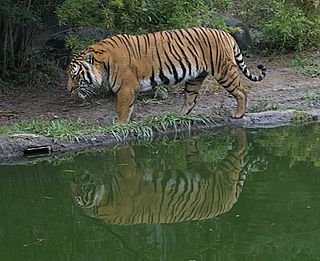
The wildlife of Laos encompasses the animals and plants found in the Lao People's Democratic Republic, a landlocked country in southeastern Asia. Part of the country is mountainous and much of it is still clad in tropical broadleaf forest. It has a great variety of animal and plant species.

The dwarf scaly-tailed squirrel is a species of rodent in the family Anomaluridae. It is found in Cameroon, Central African Republic, Republic of the Congo, Democratic Republic of the Congo, Equatorial Guinea, Gabon and Uganda. The species is nocturnal and arboreal and lives in subtropical or tropical lowland rainforest. Membranes attached to its limbs and tail enable it to glide between trees. This squirrel is currently not considered to be threatened by habitat destruction; "much of the habitat within parts of the known range of this species is relatively intact, and the species is unlikely to be experiencing any significant declines."
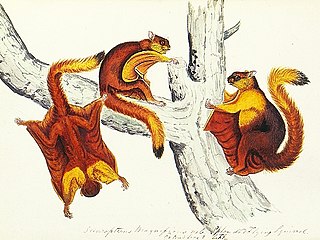
Hodgson's giant flying squirrel is a species of rodent in the family Sciuridae. This large flying squirrel lives in Himalayan forests in Asia. Like other flying squirrels, it is nocturnal and able to glide long distances between trees by spreading out its patagium, skin between its limbs.

The Bhutan giant flying squirrel, also known as the Gray's giant flying squirrel or noble giant flying squirrel, is a species of rodent in the family Sciuridae. This species lives in Himalayan forests and it is one of the largest flying squirrels. Like other flying squirrels, it is mainly nocturnal and able to glide long distances between trees by spreading out its patagium, skin between its limbs.

The Indian giant flying squirrel, also called the large brown flying squirrel or the common giant flying squirrel, is a species of rodent in the family Sciuridae. It is capable of gliding flight using a skin membrane stretched between front and hind legs. It is found in mainland Southeast and South Asia, and southern and central China.

The forest giant squirrel or Stanger's squirrel is a species of rodent in the family Sciuridae found in Angola, Benin, Burundi, Cameroon, the Central African Republic, the Republic of the Congo, the Democratic Republic of the Congo, Ivory Coast, Equatorial Guinea, Gabon, Ghana, Kenya, Liberia, Nigeria, Rwanda, Sierra Leone, Tanzania, Togo, and Uganda. Its natural habitats are subtropical or tropical moist lowland forests and plantations.

The greater monkey-faced bat or greater flying monkey is a megabat endemic to Solomon Islands, Bougainville, in Papua New Guinea, and nearby small islands. It is listed as a critically endangered species and the population is decreasing. It is the largest monkey-faced bat.

Walter's duiker is a species of duiker found in Togo, Benin and Nigeria. It was described in 2010. Its name commemorates Professor Walter Verheyen, who was the first to obtain a specimen of this species of duiker from Togo in 1968.

Centrolene savagei is a species of frog in the family Centrolenidae that is endemic to the Andes of western Colombia, specifically the Cordillera Occidental and Cordillera Central. Its common name is Savage's Cochran frog.

Pristimantis jamescameroni is a species of frog belonging to the family Strabomantidae. It is an orange-brown coloured small frog reported so far only from the Aprada-tepui, a table-top mountain in Bolívar state, Venezuela. It was discovered in June 2012 and formally described in October 2013 by Belgian biologist Philippe J. R. Kok at the Royal Belgian Institute of Natural Sciences and Vrije Universiteit Brussel. The species was named after the Hollywood filmmaker James Cameron, in recognition of his efforts in environmental awareness, and in addition to his public promotion of veganism as a way of animal conservation. Due to its restricted occurrence, the species could be classified as "endangered" according to the criteria of the IUCN Red List of Threatened Species.
Chaerephon atsinanana is a free-tailed bat found on Madagascar. It was considered a subspecies of the little free-tailed bat until 2010. During the day, they are known to roost in man-made structures such as the roofs or attics of buildings.
The Mount Gaoligong flying squirrel is a species of large, arboreal flying squirrel endemic to highland forests in southwestern China.
